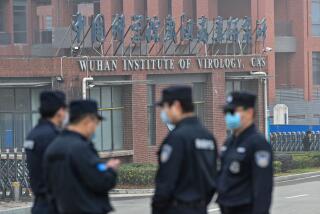Plan for Germ Warfare Facility Defended
- Share via
WASHINGTON — Ten nations, many of them hostile to the United States, currently are producing biological weapons, making it crucial that the Army pursue its controversial plan to build a germ warfare facility in Utah, a senior Defense Department official told Congress Tuesday.
Thomas Welch, assistant to the secretary of defense for nuclear, biological and chemical weapons, told three congressional committees that the United States has formally renounced any use of lethal biological weapons but must support a program to defend against them.
“We need to do the vaccine work, the protective mask work, the detectors and so on needed to prevent the soldier from the terrible suffering that would come with these . . . weapons,” Welch said.
Would Use Deadly Agents
Welch and several other top Administration officials appeared before Congress to defend plans to construct a $5.4-million biological weapons test facility at Dugway Proving Grounds, about 70 miles southwest of Salt Lake City. The planned facility would use deadly and infectious germ agents in tests of protective gear and decontamination procedures, the Army has said.
The facility has been delayed by environmental and citizen concern about the possibility of release of exotic genetically engineered viruses into the atmosphere. The Army is currently taking public comment on an environmental impact statement for the laboratory and plans to begin construction sometime in late 1991 or early 1992.
Welch said that the tests would be limited and conducted with extensive safety precautions, but an official of the Environmental Protection Agency expressed concern at the hearing that the Army would some day wish to conduct more dangerous tests at the facility.
Expresses Concern
Richard Sanderson, director of the EPA’s office of federal activities, said the agency is concerned that the Army will use live germ agents when synthetic substances would work as well and be far less dangerous.
Sanderson told lawmakers that the EPA “believes this use might be able to reduce the number of tests using disease organisms and still accomplish the (Army’s) mission.”
Rep. Wayne Owens (D-Utah), who represents the Dugway area, charged that the laboratory would have the capability to convert “lethal pathogens into aerosol form.”
“And it is this dangerous aerosol capability that is setting off alarm bells throughout the scientific community, both internationally and in Utah, as to the public safety and wisdom of building the Dugway facility,” Owens said.
The Army plans to study protection against organisms including anthrax, Q fever, tularemia and encephalitis. Army officials said that they have no intention of using laboratory-created “designer genes” at the Utah lab and that all material would be handled according to applicable federal law.
Can Be Shipped in Open Mails
In most cases, pathogens used in germ-warfare tests can be shipped in the open mails, an Army official said.
The lab would be built to the nation’s highest safety standards for a biological research facility, Biosafety Level 4 (BL-4), even though it plans to conduct tests that require only a BL-3 rating, the Army said.
Biological weapons are banned under the 1972 Biological Weapons Convention, which has been signed by 126 nations. The United States stopped producing germ warfare agents in 1969 and has since destroyed all stockpiled weapons, Welch said.
The Soviet Union, although a signatory to the 1972 convention, currently has an active biological and toxin offensive weapons program, according to Lynn Hansen, an official of the State Department’s Arms Control and Disarmament Agency.
Cites Lack of Verification
Hansen noted that the treaty has no enforcement or verification provisions and that several Middle Eastern nations now have the capacity to produce and deliver biological weapons.
When asked at the hearing about the specific nations that have biological weapons, Welch said: “I would have to address that in a closed session, and I think the director of Central Intelligence would be very pleased to do that, either individually or collectively.”
Tuesday’s testimony came before a joint hearing of the House Foreign Affairs arms control subcommittee, the Interior subcommittee on energy and the environment and the Armed Services subcommittee on military installations and facilities.
More to Read
Sign up for Essential California
The most important California stories and recommendations in your inbox every morning.
You may occasionally receive promotional content from the Los Angeles Times.













